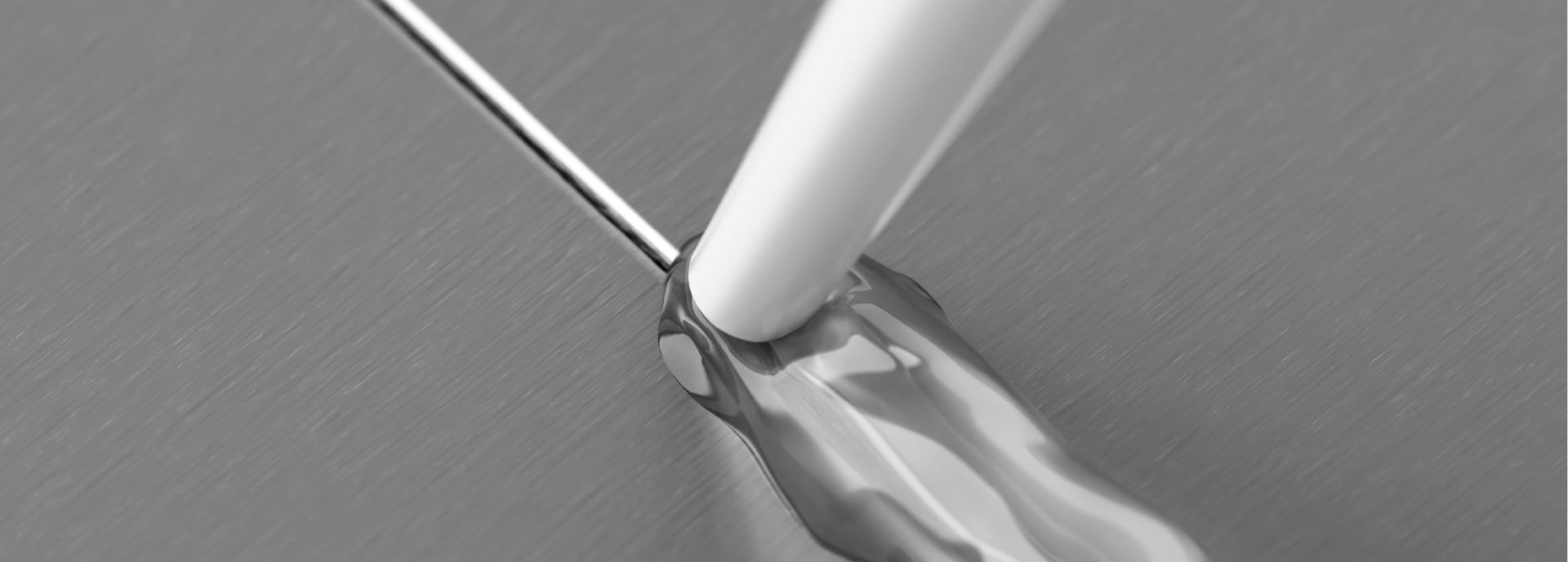In industrial environments, precise dispensing of cyanoacrylate adhesives is essential to ensure fast and reliable bonding. Used for bonding or potting applications, these low-viscosity adhesives require appropriate equipment such as syringes, valves, foot pedals, or pneumatic guns. Mastering the deposition ensures quality, repeatability, and performance of the assembly process.
What are cyanoacrylate adhesives?
Cyanoacrylates are liquid adhesives that polymerize rapidly when exposed to ambient humidity. Their low viscosity makes them compatible with conical needles, precision tips, or flexible needles. They enable pinpoint bonding and are often used in industries such as electronics, optics, or medical, with cartridges or caps ensuring product preservation.
Why adequate dispensing matters for cyanoacrylates
Micro-dispensing or volumetric dispensing of cyanoacrylates is crucial to minimize waste and prevent over-application. A static mixer is not required, but using a piston, pressurized system, or valve dispenser ensures an even deposit. This control is often paired with regulated air supply or dispensing robots to optimize production rate and precision.
Environmental impact of cyanoacrylates
Industrial adhesive application raises growing environmental concerns. Although cyanoacrylates are high-performing, they must be applied using safe dispensing equipment: airtight caps, sealed syringes, and containment systems help prevent vapors. Integrating non-contractual containment pumps limits risks to operators and the environment.
Evaluation of industrial adhesives
A technical assessment of cyanoacrylates should include their curing behavior, compatibility with substrates, and handling via cartridges or syringes. The presence of tips, manual controls, or pneumatic pedals affects process efficiency. An ill-fitted system can cause irreproducibility or cross-contamination.
Ecological alternatives
Low-environmental-impact versions, solvent-free and UV-curable, are emerging. When paired with a planetary mixer or sequential dispensing systems, they help reduce waste. Replacing disposable needles with reusable polypropylene consumables also aligns with sustainability efforts, simplifying waste management.
Cyanoacrylate dispensing guns
Dispensing guns are viable options for cyanoacrylates. Whether manual, electric, or pneumatic, they must suit product viscosity, standard cartridges, and precision needles. Certain models enable precise coating or pinpoint application, with interfaces including buttons, caps, or safety covers.
Types of cyanoacrylate dispensing guns available
Options include pneumatic foot-pedal guns, manual pressure guns, or automated systems with integrated valves. Micro-dispensing models often use angled or oval needles for complex zones. Some systems feature a feed funnel and syringe adapter to facilitate continuous deposition on automated lines.
Benefits of automatic dispensing guns
Automatic guns, paired with sequential control systems, ensure consistent volumetric dispensing even for highly fluid adhesives. They offer uniform deposition, reduce human error, and enhance repeatability. When integrated into robots, they enable precise UV wavelength control for UV-curable applications like optics or medical.
Dispensing systems
Automated dispensing systems offer high accuracy for cyanoacrylate adhesives. They include components like pumps, valves, and pistons, often paired with robots or filtered air supplies. Their ability to handle various consumables (tips, syringes, adapters) ensures maximum compatibility with modern production line requirements.
How cyanoacrylate dispensing solutions work
Operation relies on a pressurized system or volumetric pump controlled by a pneumatic valve or stepper motor. The adhesive flows from a cartridge through a static mixer (if needed), then is extruded via a precision needle. Viscosity and pressure regulation ensure uniform deposition, reducing bubbles, excess, or voids.
Advantages of uniform deposition
Uniform deposition ensures optimal adhesion without excess adhesive. It minimizes delamination or QA rejects. Automated dispensing systems, especially with robots, pressure sensors, and calibrated tips, make the process more repeatable, cut costs, and increase assembly reliability in series production.
Customized solutions
Adapting the dispensing system to your process is essential for meeting constraints like vacuum environments, occasional use, or sequential deposition. Bespoke solutions take into account syringe formats, needle types, UV curing control, and viscosity. Each industry requires tailored equipment, often with calibrated valve dispensers.
Sector-specific needs
- Electronics: Precision is key adhesives are deposited using conical needles or robotic guns.
- Optics: UV wavelength is used for polymerization, requiring UV caps and sealed pressurized systems.
- Medical: Sealing under controlled atmosphere requires pumps, pedals, and valves compatible with non-contact cartridges.
Successful case studies
In the sensor industry, micro-dispensing with brush needles and oval tips reduced product waste by 30%. In optoelectronics, a robot equipped with a volumetric dispenser and UV valve enables rapid polymerization while maintaining perfect repeatability. Each case demonstrates that selecting the right consumables and equipment is a key factor in performance.

